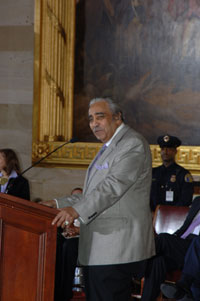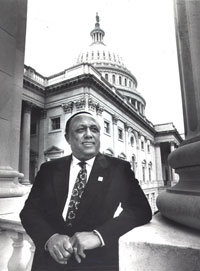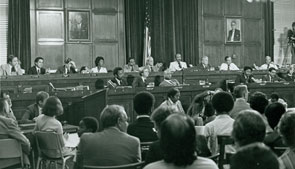Permanent Interests
The Expansion, Organization, and Rising Influence of African Americans in Congress, 1971–2007
Institutional Advancement
 Representative Charles Rangel of New York, featured in this 2007 image, has the second longest career in congressional history among African Americans.Image courtesy of U.S. House of Representatives Photography Office
Representative Charles Rangel of New York, featured in this 2007 image, has the second longest career in congressional history among African Americans.Image courtesy of U.S. House of Representatives Photography OfficeIncumbency success rates for Members of Congress have risen throughout the 20th century for the entire congressional population. African Americans, of course, have been elected in their greatest numbers in an era in which incumbency rates have remained consistently at 95 percent (the rate in 1970) or greater—indeed in the late 1980s and the 1990s it reached 98 percent.38 While the longevity of all Members of Congress increased, African-Americans’ longevity has exceeded the norm. From the World War II Era forward, black Members have served longer than the general membership.39
The average length of service for former African-American Members elected between 1964 and 2004 reached 10.1 years—higher than the 8.65-year average for the entire congressional population during that time span.40 Of the black Members who entered Congress after 1970, Charles Rangel has had the longest span of service: nearly 37 years at the end of 2007. In the history of African Americans in Congress, Rangel ranked second only to John Conyers of Michigan (also a current Member of the 110th Congress, 2007–2009), a Member for nearly 43 years by late 2007. During this era, Bill Clay, Sr., and Louis Stokes also accumulated three decades of service, with 32 and 30 years, respectively, at their retirements. By the 110th Congress, active African-American Members held an even more consequential service advantage: While the average length of service for the entire congressional population was at a near all-time high of 10.1 years, black Members averaged 12 years.41
Member Characteristics: Seniority and Leadership Posts
Longevity meant that many black Members of Congress in this era benefited from the long-standing tradition of parceling out desirable committee assignments and leadership positions to those who had accrued the most years of continuous service. The trend that awarded perquisites based on committee seniority solidified in the second decade of the 20th century in the House and remained dominant through the 1970s (and still figures prominently in the way assignments are distributed).42 “When I first came to Congress, I was opposed to the seniority system,” District of Columbia Delegate Walter Fauntroy remarked. However, he later said, “The longer I am here, the better I like it.”43 Indeed, seniority boosted the influence of black Representatives and that of the CBC in the latter part of the century. “We don’t really think that racism in this country has so diminished that given the opportunity to vote on individuals based on their experience and ability that we could overcome that without the assistance of the seniority system,” Representative Rangel acknowledged.44
Between 1971 and 1975, African-American Members eclipsed long-standing barriers on the three elite House committees: Appropriations, which originates all federal spending bills; Ways and Means, with power over taxation and revenue measures; and Rules, which reviews and structures bills passed by various committees in preparation for debate and vote by the full House. In 1971, Louis Stokes won a seat on the Appropriations Committee, becoming the first of 12 African Americans to serve on the panel in this era (the first black woman, Yvonne Brathwaite Burke of California, joined the committee in 1975). Stokes eventually served as one of the Appropriations “cardinals.”45 As chairman of the Subcommittee on Veterans Affairs, Housing and Urban Development, and Independent Agencies in the 103rd Congress (1993–1995), Stokes oversaw a huge percentage of the discretionary spending in the annual federal budget. The first African American to lead an Appropriations subcommittee was Representative Julian Dixon of California, who chaired the District of Columbia Subcommittee beginning in the 97th Congress (1981–1983).
During this period, black House Members capitalized upon decentralizing reforms to solidify and extend gains in terms of committee assignments and leadership positions. In 1974, control of committee assignments of Democratic Members was transferred from the Ways and Means Committee (then chaired by Wilbur Mills of Arkansas) to the Democratic Steering and Policy Committee, chaired by the Speaker of the House. The CBC used the opportunity to pressure House leaders, including Speaker Carl Albert of Oklahoma, to place African Americans on prominent committees. Under Representative Rangel’s leadership, the group struck a deal with Speaker Albert stipulating that at least one African-American Member would serve on each of the major standing committees.46 The ability of the CBC to attain more-attractive committee assignments was one of a handful of “clear achievements of black representatives organizing as a Caucus.”47 As a result of the new agreement between the CBC and the House leadership, each of the highest-ranking House committees included at least one African-American Member on its roster during the 94th Congress (1975–1977).48
Throughout its history, the CBC continued to rally to the support of individual black Members seeking to make institutional inroads that would better position them to secure some of their legislative goals. One example was the case of Ronald Dellums, a vocal critic of the Vietnam War, who faced resistance when he announced his interest in serving on the Armed Services Committee, chaired by longtime southern Democrat F. Edward Hébert of Louisiana. The CBC, led by Stokes and Clay, drafted a letter to the Democratic leadership on behalf of Dellums. When Speaker Albert informed Stokes that the CBC could have a black Member on Armed Services, but not Dellums, Stokes angrily replied that “white people don’t tell black people who their leaders are.”49 With the backing of the CBC, Dellums became the first black to serve on the Armed Services Committee.
Rising rank within the committee system had a reinforcing effect on the CBC. By the 99th Congress (1985–1987), CBC membership had grown to 20—only seven more than the original number in 1971.50 But despite this modest numerical gain, African Americans chaired an unparalleled five standing committees, two select committees, and 16 subcommittees in the 99th Congress.51 “We don’t have to go hat in hand begging anybody,” Representative Clay observed. “In fact, it’s just the reverse. Now a lot of people have to come hat in hand [to us] asking us for favors.”52
 In the 103rd Congress (1993–1995), a large turnover among the House Membership allowed Lucien Blackwell of Pennsylvania to make the largest jump in seniority of any returning Member. Blackwell traded his assignment on Merchant Marine and Fisheries for a coveted position on the Budget Committee.Image courtesy of Philadelphia Inquirer
In the 103rd Congress (1993–1995), a large turnover among the House Membership allowed Lucien Blackwell of Pennsylvania to make the largest jump in seniority of any returning Member. Blackwell traded his assignment on Merchant Marine and Fisheries for a coveted position on the Budget Committee.Image courtesy of Philadelphia InquirerOf the 18 African Americans who have held House committee chairmanships in congressional history, 16 attained those positions in the post-1970 era. Five have held at least two chairmanships, and Augustus (Gus) Hawkins of California held chairmanships on four committees: Education and Labor; House Administration; Joint Committee on Printing; and Joint Committee on the Library.53 Additionally, of the 46 African-American Members who have chaired subcommittees in Congress, 41 attained those posts for the first time in the post-1970 period.54 Such presence within the echelons of the leadership constituted a significant base of institutional support. In summary, these developments indicated that African Americans were now represented throughout the committee structure of the House—ranging from constituency-oriented panels to power committees—and provided powerful evidence of their assimilation into the institution.55
During the era from 1971 through 2007, black Members made history by attaining posts in the leadership ranks of both major parties in the House. John Conyers made the first effort to attain a leadership post by challenging then-Majority Leader Carl Albert for the speakership in 1971. Conyers lost the Democratic Caucus vote 220 to 20 in what was widely described as a symbolic undertaking.56 But African-American Members made inroads in other leadership routes during this era. Barbara Jordan of Texas, Ralph Metcalfe of Illinois, and Harold E. Ford, Sr., of Tennessee, for instance, were early appointees to the Democratic Steering and Policy Committee, which set the parameters of the party’s legislative agenda in addition to parceling out committee assignments. In 1983, Speaker Thomas P. (Tip) O’Neill of Massachusetts chose Representative Rangel as a Deputy Majority Whip, making the New York Representative one of the most powerful Democrats in the House. John Lewis later served as Chief Deputy Democratic Whip.57
Just four African Americans have held elected positions within the Democratic Caucus and Republican Conference. Shirley Chisholm held the position of Democratic Caucus Secretary in the 95th and 96th Congresses (1977–1981). Bill Gray made the most dramatic climb up the leadership ladder: After winning the position of Democratic Caucus chairman in December 1988, he made history six months later when his colleagues elected him Democratic (Majority) Whip. As the first African American to hold the post, Gray was the third-ranking Democrat in the House. Others followed his lead. In 1999, J. C. Watts of Oklahoma became the highest-ranking African American in the history of the Republican Party when his GOP colleagues elected him Chairman of the Republican Conference; he held the position until his retirement from the House in 2003.58 James Clyburn of South Carolina served as Chairman of the Democratic Caucus for part of the 109th Congress, relinquishing that post to Rahm Emanuel of Illinois in November 2006, and becoming the second African American to hold the position of Majority Whip.59
Footnotes
- Morris P. Fiorina, “Legislative Incumbency and Insulation,” in The Encyclopedia of American Legislative Systems, Volume 1, Silbey, ed.: 516–518.
- Roughly one-third (32 of the 97 African Americans to enter the House since 1943) have served more than 14 years—compared with roughly 29 percent of all House Members, and nearly 18 percent (17 of 97) have served 20 or more years—compared with about 15 percent of the general membership. General House Member statistics are drawn from David C. Huckabee, “Length of Congressional Service: First Through 107th Congresses,” 9 August 2002, Report RS21285, Congressional Research Service (hereinafter referred to as CRS), Library of Congress, Washington, DC.
- See, for instance, Mildred Amer, “Average Years of Service for Members of the Senate and House of Representatives, First through 109th Congresses,” 9 November 2005, Report RL32648, CRS.
- See the chart on Members’ terms of service from 1965 through 2007, at the end of this essay. See also Mildred Amer, “Membership of the 110th Congress: A Profile,” 12 September 2007, Report RS22555, CRS. The Congress with the longest average length of service was the 102nd (1991–1993), which was 10.4 years.
- On the general topic of centralization of power in the House that gave rise to the hierarchical committee system, see Peter Swenson, “The Influence of Recruitment on the Structure of Power in the U.S. House, 1870–1940,” Legislative Studies Quarterly VII (February 1982): 7–36. For an analysis of committee seniority, see Michael Aboam and Joseph Cooper, “The Rise of Seniority in the House of Representatives,” Polity 1 (Fall 1968): 52–84. For an analysis of factors that mitigate seniority as the determining factor in committee hierarchy as well as a discussion of when the seniority system solidified in the House, see Nelson Polsby, Miriam Gallaher, and Barry S. Rundquist, “The Growth of the Seniority System in the U.S. House of Representatives,” American Political Science Review 63 (September 1969): 787–807.
- Eric Pianin, “Black Caucus Members Face Dilemma of Hill Loyalties,” 23 September 1987, Washington Post: A1.
- Milton Coleman, “Black Caucus Comes of Age,” 7 January 1985, Washington Post: A1.
- “Cardinals” alludes to the College of Cardinals of the Catholic Church who set church policy. In this usage, the term conveys the authority of the Appropriations Committee subcommittee chairs—each of whom has control over allocations for a portion of the federal budget.
- Swain, Black Faces, Black Interests: 38.
- Barnett, “The Congressional Black Caucus”: 46.
- Richard D. Lyons, “Ways and Means in Liberal Shift,” 12 December 1974, New York Times: 38. The elite committee Members included Louis Stokes on Appropriations, Charles Rangel and Harold Ford, Sr., on Ways and Means, and Andrew Young on Rules. During this era, African Americans also registered major gains on second-tier committees where none had previously served, including Banking and Currency (Parren Mitchell, 1971), Budget (Mitchell, 1974), Energy and Commerce (Cardiss Collins and Mickey Leland, 1981), and Public Works (George Collins and Charles Rangel, 1971). The most common committee assignment for African-American Members during this era was the Small Business Committee, created in 1974. Including the first, Parren Mitchell, a total of 31 black Members have served on the committee through 2007. Since 1971, a total of 21 black Members have served on the Transportation and Infrastructure Committee (and its previous iterations, Public Works and Public Works and Transportation), another 21 African Americans have served on the Oversight and Government Reform Committee (and its previous iterations, Government Reform, Government Reform and Oversight, and Government Operations), and 20 have served on the Education and Labor Committee (and its predecessor, Education and the Workforce).
- Quoted in Singh, The Congressional Black Caucus: 79. According to Dellums’s recollections in Lying Down With the Lions, the CBC helped him get a spot on Armed Services in 1973.
- At the opening of the 99th Congress there were 20 African Americans in Congress. Alton Waldon, Jr., of New York became the 21st black Member to serve in the 99th Congress after he won a special election on June 10, 1986.
- Nadine Cohadas, “Black House Members Striving for Influence,” Congressional Quarterly Weekly Report 43 (13 April 1985): 675; Singh, The Congressional Black Caucus: 92; Coleman, “Black Caucus Comes of Age.”
- Cohadas, “Black House Members Striving for Influence”: 675.
- See Appendix E, Black Americans Who Have Chaired Congressional Committees. In the modern era, no African Americans have held full or select committee chairmanships in the Senate. Only Blanche Bruce of Mississippi has led Senate panels: the Select Committee to Investigate the Freedmen’s Savings and Trust Company in the 46th Congress and the Select Committee on the Mississippi River in the 44th Congress.
- See Appendix F, Black-American Chairs of Subcommittees of Standing Committees in the U.S. House and Senate, 1885–2007. James O’Hara, Adam Clayton Powell, William Dawson, Robert Nix and Charles Diggs, held subcommittee chairmanships before 1970. Nix and Diggs also held subcommittee chairman posts after 1970.
- See, for example, Carol Swain, “Changing Patterns of African-American Representation in Congress,” in The Atomistic Congress: An Interpretation of Congressional Change, Allen D. Hertzke and Ronald M. Peters, Jr. (Armonk, NY: M.E. Sharpe, Inc., 1992): 132.
- Swain, “Changing Patterns of African-American Representation in Congress”: 129.
- Black Members also held minor leadership positions during this era. For example, Shirley Chisholm served as Secretary of the Democratic Caucus, Cardiss Collins was the first black woman to serve as an At-Large Democratic Whip, and Parren Mitchell also served as an At-Large Democratic Whip.
- For an analysis of J. C. Watts’s House career with an emphasis on his challenging task of building bridges between the Republican Party and black voters, see Jake Tapper, “Fade to White: The Only African American Republican in Congress Is Headed Home. Can the Party of Lincoln—and Trent Lott—Afford the Loss of J. C. Watts?” 5 January 2003, Washington Post Magazine: W06.
- For analyses of Clyburn’s leadership and his ascendancy within the context of the rising influence of southern blacks in Congress, see Richard E. Cohen, “A Different Kind of Whip,” 20 January 2007, National Journal: 42–44; David Rogers, “Clyburn Leads Southern Blacks’ Ascent to Top Posts in Congress,” 3 January 2007, Wall Street Journal: A5; and Jennifer Yachnin, “No ‘Sharp Elbows’ for Whip Clyburn,” 11 December 2006, Roll Call.

